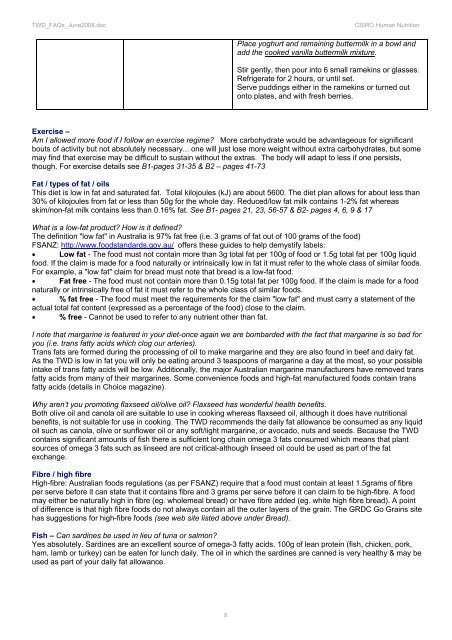The CSIRO Total Wellbeing Diet Frequently Asked Questions
The CSIRO Total Wellbeing Diet Frequently Asked Questions
The CSIRO Total Wellbeing Diet Frequently Asked Questions
You also want an ePaper? Increase the reach of your titles
YUMPU automatically turns print PDFs into web optimized ePapers that Google loves.
TWD_FAQs_June2008.doc <strong>CSIRO</strong> Human Nutrition<br />
8<br />
Place yoghurt and remaining buttermilk in a bowl and<br />
add the cooked vanilla buttermilk mixture.<br />
Stir gently, then pour into 6 small ramekins or glasses.<br />
Refrigerate for 2 hours, or until set.<br />
Serve puddings either in the ramekins or turned out<br />
onto plates, and with fresh berries.<br />
Exercise –<br />
Am I allowed more food if I follow an exercise regime? More carbohydrate would be advantageous for significant<br />
bouts of activity but not absolutely necessary... one will just lose more weight without extra carbohydrates, but some<br />
may find that exercise may be difficult to sustain without the extras. <strong>The</strong> body will adapt to less if one persists,<br />
though. For exercise details see B1-pages 31-35 & B2 – pages 41-73<br />
Fat / types of fat / oils<br />
This diet is low in fat and saturated fat. <strong>Total</strong> kilojoules (kJ) are about 5600. <strong>The</strong> diet plan allows for about less than<br />
30% of kilojoules from fat or less than 50g for the whole day. Reduced/low fat milk contains 1-2% fat whereas<br />
skim/non-fat milk contains less than 0.16% fat. See B1- pages 21, 23, 56-57 & B2- pages 4, 6, 9 & 17<br />
What is a low-fat product? How is it defined?<br />
<strong>The</strong> definition "low fat" in Australia is 97% fat free (i.e. 3 grams of fat out of 100 grams of the food)<br />
FSANZ: http://www.foodstandards.gov.au/ offers these guides to help demystify labels:<br />
• Low fat - <strong>The</strong> food must not contain more than 3g total fat per 100g of food or 1.5g total fat per 100g liquid<br />
food. If the claim is made for a food naturally or intrinsically low in fat it must refer to the whole class of similar foods.<br />
For example, a "low fat" claim for bread must note that bread is a low-fat food.<br />
• Fat free - <strong>The</strong> food must not contain more than 0.15g total fat per 100g food. If the claim is made for a food<br />
naturally or intrinsically free of fat it must refer to the whole class of similar foods.<br />
• % fat free - <strong>The</strong> food must meet the requirements for the claim "low fat" and must carry a statement of the<br />
actual total fat content (expressed as a percentage of the food) close to the claim.<br />
• % free - Cannot be used to refer to any nutrient other than fat.<br />
I note that margarine is featured in your diet-once again we are bombarded with the fact that margarine is so bad for<br />
you (i.e. trans fatty acids which clog our arteries).<br />
Trans fats are formed during the processing of oil to make margarine and they are also found in beef and dairy fat.<br />
As the TWD is low in fat you will only be eating around 3 teaspoons of margarine a day at the most, so your possible<br />
intake of trans fatty acids will be low. Additionally, the major Australian margarine manufacturers have removed trans<br />
fatty acids from many of their margarines. Some convenience foods and high-fat manufactured foods contain trans<br />
fatty acids (details in Choice magazine).<br />
Why aren’t you promoting flaxseed oil/olive oil? Flaxseed has wonderful health benefits.<br />
Both olive oil and canola oil are suitable to use in cooking whereas flaxseed oil, although it does have nutritional<br />
benefits, is not suitable for use in cooking. <strong>The</strong> TWD recommends the daily fat allowance be consumed as any liquid<br />
oil such as canola, olive or sunflower oil or any soft/light margarine, or avocado, nuts and seeds. Because the TWD<br />
contains significant amounts of fish there is sufficient long chain omega 3 fats consumed which means that plant<br />
sources of omega 3 fats such as linseed are not critical-although linseed oil could be used as part of the fat<br />
exchange.<br />
Fibre / high fibre<br />
High-fibre: Australian foods regulations (as per FSANZ) require that a food must contain at least 1.5grams of fibre<br />
per serve before it can state that it contains fibre and 3 grams per serve before it can claim to be high-fibre. A food<br />
may either be naturally high in fibre (eg. wholemeal bread) or have fibre added (eg. white high fibre bread). A point<br />
of difference is that high fibre foods do not always contain all the outer layers of the grain. <strong>The</strong> GRDC Go Grains site<br />
has suggestions for high-fibre foods (see web site listed above under Bread).<br />
Fish – Can sardines be used in lieu of tuna or salmon?<br />
Yes absolutely. Sardines are an excellent source of omega-3 fatty acids. 100g of lean protein (fish, chicken, pork,<br />
ham, lamb or turkey) can be eaten for lunch daily. <strong>The</strong> oil in which the sardines are canned is very healthy & may be<br />
used as part of your daily fat allowance.
















